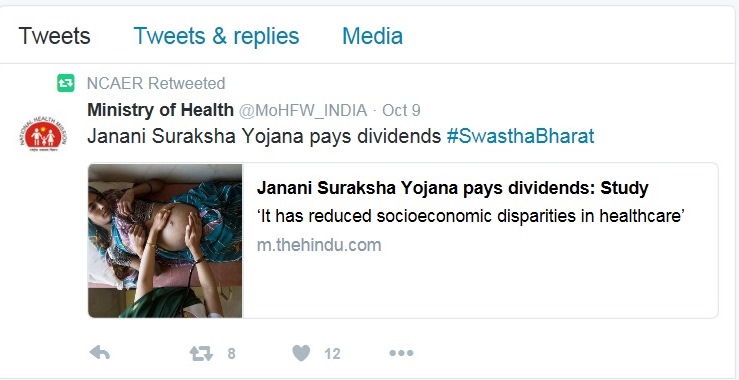Janani Suraksha Yojana pays dividends: Study
10 Oct 2016
A new study brings in first conclusive evidence of the role played by Janani Suraksha Yojana (JSY) in reducing ‘socioeconomic disparities’ existing in maternal care.
The JSY was launched in 2005 as part of the National Rural Health Mission (NRHM) to improve maternal and neonatal health by promotion of institutional deliveries (childbirth in hospitals).
According to a working paper by Ruchi Jain (NCAER) Sonalde Desai (NCAER University of Maryland) and Reeve Vanneman (University of Maryland) “JSY has led to an enhancement in the utilisation of health services among all groups especially among the poorer and underserved sections in the rural areas thereby reducing the prevalent disparities in maternal care.”
While previous studies had shown the impact of JSY in reducing maternal mortality it was not known if it had reduced socioeconomic inequalities — differences in access to maternal care between individual people of higher or lower socioeconomic status.
The study was conducted using data from two rounds of the India Human Development Survey (IHDS) — conducted in 2004-05 and 2011-12. The IHDS data serves two advantages in this case. First round 1 of IHDS was conducted in 2004-05 when the JSY was not in place and round two was conducted six years after the launch providing a before-after scenario for comparison. Secondly the IHDS is a longitudinal data set — same households were interviewed in both rounds which allows to examine changes in maternal care patterns.
Three key services of maternal care were used for the analysis: full antenatal care (full ANC) safe delivery and postnatal care.
There were three major findings. First the increase in utilisation of all three maternal healthcare services between the two rounds was remarkably higher among illiterate or less educated and poor women.
“This documents the effect of the JSY scheme where women with little or no education were motivated to utilise maternal health care services” the study says.
Reducing disparities
Secondly the usage of all three maternal healthcare services by the OBC Dalit Adivasis and Muslim women increased between the surveys.
The study found that after the implementation of the JSY “there was generally a narrowing of the gap between the less educated and more educated women and between the poorer and richer women.”
It was found in the survey that women in their early twenties were more likely to avail of each of the three maternal health care services as compared to their older women. Also the incidence of women availing maternal healthcare services decreases with the increase in the number of children they have delivered.
Note that inequality in access to maternal care persists. The study however notes that the gap in access to healthcare between the marginalised group of women and those who are financially better-off has declined since the advent of the JSY program.
High incidence of maternal mortality continue to plague India. As per the latest Lancet series on maternal health India accounted for 15 per cent of the total maternal deaths in the world in 2015 — second only to Nigeria — with 45000 women dying during pregnancy or childbirth.

Published in: The Hindu October 10 2016







